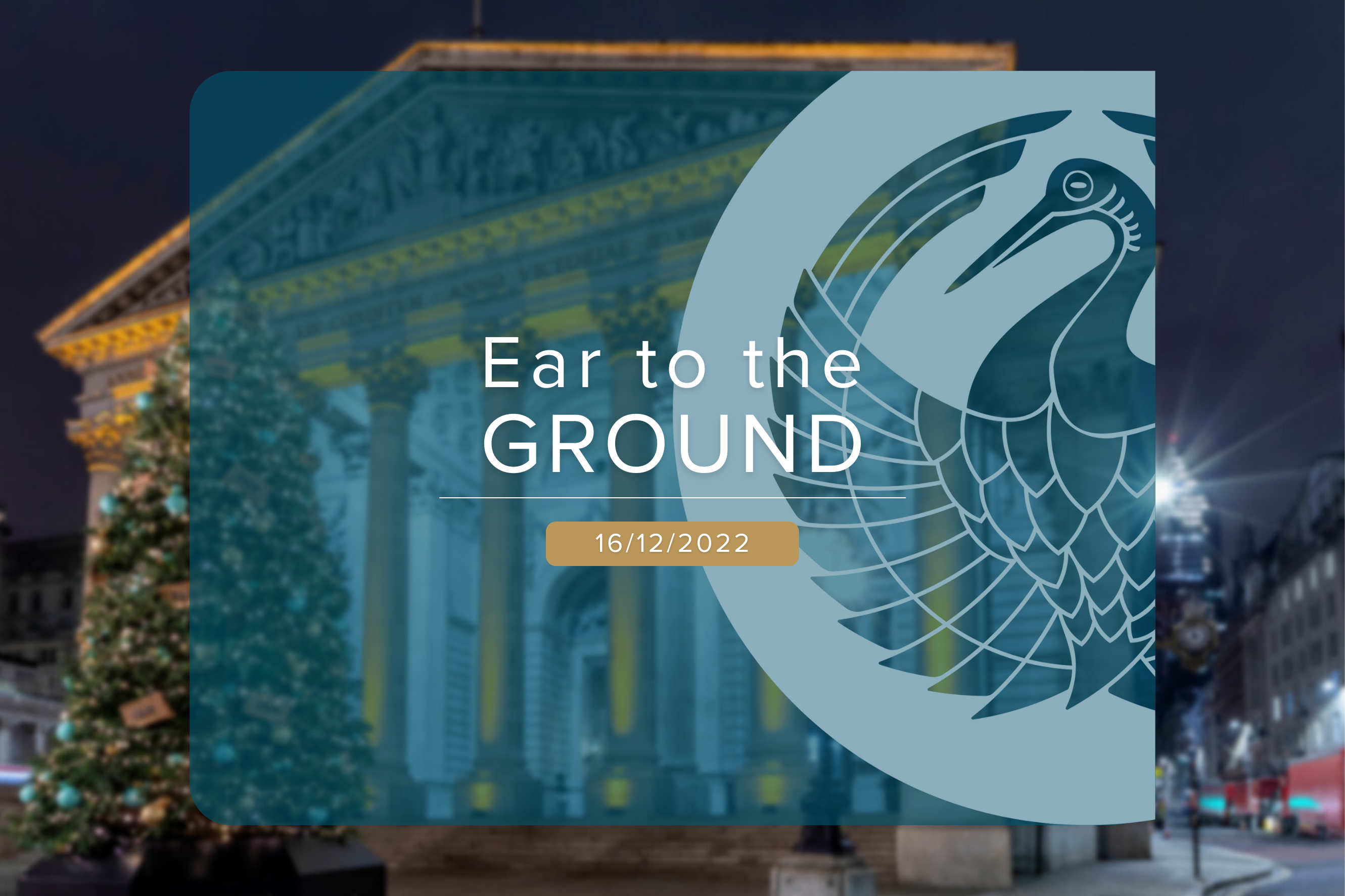Ear to the ground
16 December 2022

‘Follow the leader’! Or instead of a game of ‘Simon Say’s’, are we currently witnessing a game of ‘Powell Say’s’? This week was a week for interest rate decisions, with respective committees meeting in the US, UK and the EU. First up we had the US Federal Reserve who, as expected, raised interest rates by 0.5% to the 4.25%-4.50% range. This was the seventh consecutive rate hike. Whilst the pace of rate increases slowed, it would appear that this is by no means the last. The committee reinforced that ongoing rate hikes would be appropriate in order to reach a position where monetary policy is restrictive enough to return inflation to 2%.
The Fed delivered its rate hike after the release of the latest inflation data, which saw CPI to November slow for the 5th straight month to 7.1%, below consensus forecast of 7.3% and below the previous reading of 7.7%. Whilst items still continue to rise, such as energy and food, the rate at which they are rising slowed.
The meeting saw the latest release of the Fed Dot Plot, which shows where the individual members expect interest rates to be moving forward. The consensus for the end of 2023 is now 5.1%, with a relatively tight range of 4.9% to 5.7%. The median for 2024 meanwhile is 4.1%, but here the range of opinion is much greater, from a low of 3.1% to a high of 5.7%, just showing how divided opinions remain as to how quickly inflation will subside and how quickly the Fed will respond to a slowing economy.
The forecast for higher rates comes despite the afore mentioned fall in inflation. Indeed, the latest Fed forecast for peak in rates is higher than that in the previous Fed Dot Plot. The peak is also expected by the Fed to still be in place at the end of 2023. This contradicts market expectations that the Fed will be cutting rates as we head through next year, in response to the expected slowdown in economic growth. This begs the question as to who is wrong, the Fed who thought that inflation was transitory, or a market who still believes that the central bank will always come running to save the day, as it has done so, so many times in the recent past. That is a tough and brave call to make right now.
Next up we had the Bank of England, who also raised the base rate by 0.5%, to 3.5%. Whilst this move was expected, the dissent within the ranks was perhaps not. It was a 6-3 majority vote which sealed the move, with two MPC members having voted for no rate rise, whilst one was much more aggressive and voted for a 0.75% move. Where they did agree however was that if, moving forward, the outlook suggested more persistent inflationary pressures, it would continue to tighten monetary policy as necessary.
Projections made by the Bank suggested that inflation had reached its peak, although it was likely to remain very high in the coming months. Indeed, CPI was also released this week which showed a rate of 10.7% compared to 12 months earlier. This was lower than the previous reading of 11.1% to October and also below the consensus forecast of 10.9%. Still, however, it remains elevated all the same and way above a level which the central bank is mandated to achieve and comfortable with. It is also a level which the consumer is uncomfortable with, with average earnings including bonuses currently running at 6.1%, meaning in real terms they continue to see their spending power eroded.
Finally it was the turn of the ECB to set monetary policy for the Euro area and it was perhaps here where the central bank could perhaps be interpreted as being the most aggressive from their previous stance. Whilst they also raised rates by 0.5%, taking the refinancing rate to 2.5%, it was the statements which accompanied the rise that were more worthy of note. President Lagarde was quick to emphasize to the market that the slower rate of increase of 0.5%, rather than like the previous 0.75% hikes, “is not a pivot; we intend to keep policy very tight for the long run until inflation slows to 2%.”
This implies that the ECB is ready to hike rates potentially a lot further than the market had anticipated. This should not be surprising given the higher rate of inflation which they now forecast, expecting 8.4% in 2022, 6.3% in 2023 before averaging 3.4% in 2024. The central bank will also commence quantitative tightening in Q1 next year. Whilst this will be a small €15bn a month in the first instance, it is likely to increase during the year. There was also an admission that monetary policy was likely to push the Euro area into recession, the economy expected to contract in this quarter and the next, at least. To break one thing, inflation, it needs to break another, the economy. The ECB potentially aren’t the only ones!
This article is for information purposes only and should not be construed as advice. We strongly suggest you seek independent financial advice prior to taking any course of action.
The value of this investment can fall as well as rise and investors may get back less than they originally invested. Past performance is not necessarily a guide to future performance.
The Fund is suitable for investors who are seeking to achieve long term capital growth.
The tax treatment of investments depends on the individual circumstances of each client and may be subject to change in the future. The above is in relation to a UK domiciled investor only and would be different for those domiciled outside the UK. We strongly suggest you seek independent tax advice prior to taking any course of action.
Subscribe Today
To receive exclusive fund notifications straight into your inbox, please complete this form.